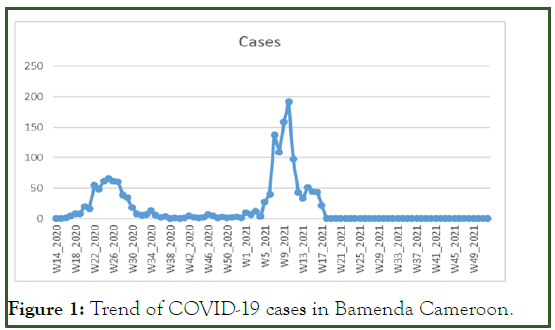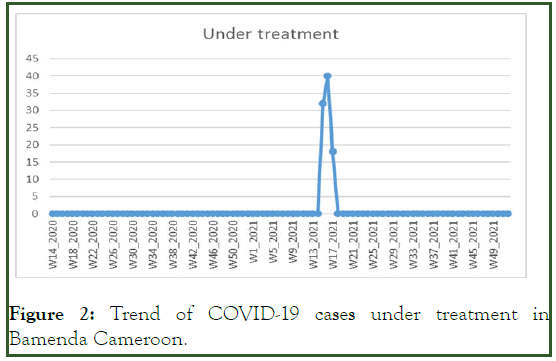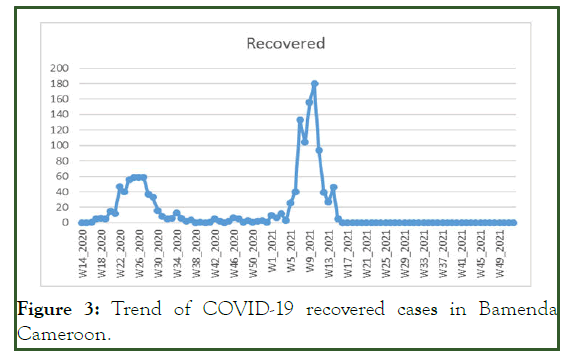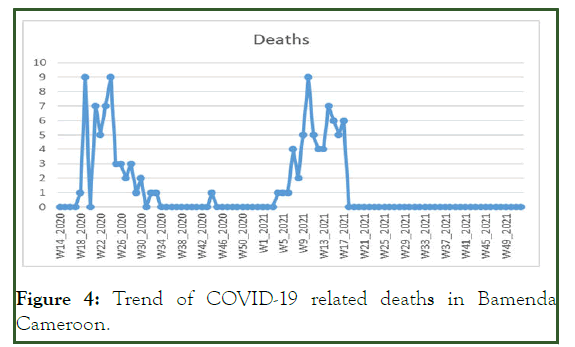Indexed In
- Academic Journals Database
- Open J Gate
- Genamics JournalSeek
- JournalTOCs
- China National Knowledge Infrastructure (CNKI)
- Scimago
- Ulrich's Periodicals Directory
- RefSeek
- Hamdard University
- EBSCO A-Z
- OCLC- WorldCat
- Publons
- MIAR
- University Grants Commission
- Geneva Foundation for Medical Education and Research
- Euro Pub
- Google Scholar
Useful Links
Share This Page
Open Access Journals
- Agri and Aquaculture
- Biochemistry
- Bioinformatics & Systems Biology
- Business & Management
- Chemistry
- Clinical Sciences
- Engineering
- Food & Nutrition
- General Science
- Genetics & Molecular Biology
- Immunology & Microbiology
- Medical Sciences
- Neuroscience & Psychology
- Nursing & Health Care
- Pharmaceutical Sciences
Research Article - (2023) Volume 14, Issue 3
COVID-19 Vaccination and Related COVID-19 Prevalence Variables in the North West Region of Cameroon
Ngwemanjong Elizabeth Alondi* and Mary Bi Suh AtangaReceived: 20-Oct-2021, Manuscript No. JVV-21-13867; Editor assigned: 25-Oct-2021, Pre QC No. JVV-21-13867(PQ); Reviewed: 08-Nov-2021, QC No. JVV-21-13867; Revised: 02-Feb-2023, Manuscript No. JVV-21-13867(R); Published: 02-Mar-2023, DOI: 10.35248/2157-7560.23.14.517
Abstract
COVID-19 vaccination and prevalence issues or variables of the disease point to the fact that delays in acceptance or refusal of vaccines despite availability at vaccination services constitue active reflections round the world. The prevalence issues include summary of cases, weekly trends and trends on cases, weekly recovery and related deaths. These constituted the objectives of this communication following records of surveys conducted at Bamenda regional hospital in the North West region of Cameroon. The primary source data was collected on COVID-19 related variables beginning from the period when the vaccines were introduced at the Bamenda regional hospital for the past 92 weeks. In the compilation, the results show that the average number of cases in the past 92 weeks is 17.57, the weekly number of cases fluctuated between 0-50 in 2020 but increased in 2021, the weekly number under treatment increased to 40 persons, recovery rates were high in the late 2020 and early 2021 but increase number of deaths by mid-2021. This information concludes that the vaccination is very necessary as literature shows that it has an impact on reducing the spread of the pandemic and the severity of the COVID-19 pandemic. It is therefore recommended that sensitization measures be increase to increase vaccine uptake and hence decreased vaccine skepticism relative to vague or negative transparent messages.
Keywords
COVID-19; Current situation; Vaccination; Bamenda; Cameroon
Introduction
Several studies have been conducted across the globe to link COVID-19 vaccines with the number of COVID-19 cases. Some of such studies includes those of. In a recent review of such studies, concluded that perceptions of vaccine safety and effectiveness are universally consistent determinants of COVID-19 vaccine hesitancy. Surveys which specifically asked COVID-19 vaccine hesitant participants their reason for vaccine refusal or delay consistently report that concerns over safety and efficacy are among the most common reasons given [1]. Similarly, qualitative research has also highlighted these worries as reported drivers of COVID-19 vaccine hesitancy among smaller and at risk groups. Such concerns may be driven by COVID-19 vaccine misinformation. Recent research has identified vulnerability to misinformation as a relationship of COVID-19 vaccine hesitancy.
Few studies have experimentally investigated the effects of COVID-19 vaccine information on interrelated attitudes and intentions [2]. Most have focused on theoretical vaccines due to the lack of accepted vaccines at the time of research. Survey research show that participants unsurprisingly express greater favorite for more effective vaccines with fewer side effects, ceteris paribus. However, experimental studies which have examined the impact of COVID-19 vaccine evidence on behavioral intentions report diverse results [3]. Reported that transparent positive messages signaling a safe and effective fictional COVID-19 vaccine decreased vaccine disbelief relative to unclear or negative transparent messages. However, no control group was included in the study leaving it undecided which interventions shifted opinions relative to a baseline [4].
Motta et al. in another messaging research reported that messages framed to emphasis the collective benefits of vaccination or the risks of not vaccinating increased participants vaccine intentions. However, the presence or absence of information about the exactness of clinical trials had no influence on intentions. Find that messages stress vaccine efficacy and safety had a slightly significant outcome on vaccine intentions relative to a control group, while an opposite message demanding planned vaccines were neither effective nor safe had no main consequence on intentions [5]. Equally, in a pre post design experiment report that disclosure to a range of factual information about potential COVID-19 vaccines has no effect on vaccine intentions, while COVID-19 vaccine misinformation decreases vaccination intentions. Reports that short messages framing vaccination as protecting either oneself or others have no effect on reported vaccination intentions [6].
The prevailing pandemic of COVID-19 in a period when the vaccine has been introduced has spurred thinkers to begin to wonder around such a situation. There is therefore a wave of current research to investigate the impact of the vaccine on the prevalence of the COVID-19. For instance, study from Canada analyzing data from over 200000 COVID-19 cases showed a rise in virulence of the delta variant when compared to non-VOCs [7]. Among the COVID-19 cases, the risk of hospitalization, ICU admission and death associated with the delta variant compared to non-VOCs increased by 120% (93153%), 287% (198%-399%) and 137% (50%-230%), respectively. Increased disease harshness was also recognized for alpha, beta and gamma variants combined when compared to non-VOCs 59% (49%-69%) for hospitalization, 105% (82%-134%) for ICU admission and 61% (40%-87%) for death [8].
Haven noted, more than 2.5 million people are assessed to have died from COVID-19 pandemic and widespread restrictions have been placed on people across the globe, with social and economic consequences. Mass vaccination has been seen as an ending move to end the pandemic [9]. However, for permanent and widespread protection, this relies firstly on vaccines being developed to reduce transmission of the disease rather than simple individual protection, and secondly, sufficient uptake of the vaccine to produce herd immunity which is a level of population immunity at which an infectious agent is no longer able to spread. Evaluations of the percentage of the population required to be vaccinated to achieve this goal vary and depends on the local reproduction rate of the virus, with most
evaluations in the 60%-80% range [10]. A substantial minority of people around the world express hesitancy towards taking COVID-19 vaccines defined as a delay in acceptance or refusal of vaccines despite availability of vaccination services. Aspects such as religion, gender, age, political ideology, these attitudes can be accountable for this active worldwide debate. This write thus exposes some variables in relation to COVID-19 and vaccination from data gathered at the bamenda regional hospital, North West Cameroon [11].
Questions
• What is the current situation of the COVID-19 pandemic given the introduction of the vaccines?
• What is the weekly trend of the number of COVID-19 cases with availability of the vaccines?
• What is the weekly trend of COVID-19 cases under treatment given that vaccines exist?
• What is the weekly recovery rate of COVID-19 cases?
• What is the weekly COVID-19 related deaths?
Objectives were set to reflect the above questions thus: to expose the summary of COVID-19 cases, weekly trends in the numbers, weekly trend of cases under treatment, weekly recovery rates and deaths.
Materials and Methods
Data from the statistics unit of the Bamenda regional hospital was used in the compilation. Descriptive and inferential statistics was used and frequency distribution tables, charts and graphs used to describe the numeric data collected on the actual state of COVID-19 in Bamenda, North West region of Cameroon given the introduction and use of the vaccines [12].
The data that was collected from agencies in Bamenda including the main agency which is the Bamenda regional hospital surrounded the COVID-19 related variables beginning from the period when the vaccines were introduced at the Bamenda regional hospital for the past 92 weeks [13]. The findings are reported as follows demonstrated by descriptive statistics for the COVID-19 variables (Table 1).
| Variable | Obs | Mean | Std Dev | Min | Max |
|---|---|---|---|---|---|
| Cases | 92 | 17.57609 | 35.07268 | 0 | 192 |
| Under treatment | 92 | 0.978261 | 5.606076 | 0 | 40 |
| Recovered | 92 | 15.32609 | 33.22885 | 0 | 180 |
| Deaths | 92 | 1.25 | 2.374892 | 0 | 9 |
Table 1: Summary descriptive statistics of COVID-19 variables.
The summary descriptive statistics reported on Table 1 shows that for the past 92 weeks, the average number of COVID-19 cases in Bamenda, North West region of Cameroon is 17.57 cases. The minimum value of 0 shows that there were some weeks wherein there was no COVID-19 cases recorded in Bamenda, North West region of Cameroon. A maximum value of 192 shows that the maximum number of COVID-19 cases per week in Bamenda, North West region of Cameroon is 192 recorded cases of COVID-19.
Results and Discussion
The number of persons under treatment shows that at least every week, approximately 1 person goes under treatment for COVID-19 per week [14]. On an average, 15 persons with COVID-19 recover per week. This indicates some evidence that the administration of the vaccines has reduced COVID-19 related deaths given that only approximately 1 person die per week in Bamenda, North West region of Cameroon due to COVID-19 as opposed to an average of 5 deaths per week before the arrival of the vaccine (Figure 1) [15].

Figure 1: Trend of COVID-19 cases in Bamenda Cameroon.
The trend show that the weekly number of cases were fluctuating between 0 to 50 cases in 2020 but at the beginning of 2021, the number of cases per week moved up and began to fluctuate between 50 to about 200 cases per week. We note that beginning from week 17 of 2021, the number of weekly COVID-19 cases in Bamenda, North West region of Cameroon dropped and remained low [16,17]. This could be justified by the relative acceptance of the vaccines by the population in Bamenda, North West region of Cameroon. The survey information revel that amongst these cases, severe cases are those who have not taken the vaccines (Figure 2).

Figure 2: Trend of COVID-19 cases under treatment in Bamenda Cameroon.
The trend for the number of COVID-19 cases under treatment in Bamenda, North West region of Cameroon show that from week 13 to week 17 of 2021, the number of cases under treatment increases drastically to 40 persons per week that go under treatment [18]. The detail survey information as found in the records shows that those under treatment are mostly those who have not taken the vaccines. Patients under treatment that had been vaccinated but still became infected and are under treatment, are not as severe as those that have taken the vaccines. This fundamentally reveals that the vaccines could have reduced the severity of the COVID-19 cases in Bamenda, North West region of Cameroon (Figure 3) [19].

Figure 3: Trend of COVID-19 recovered cases in Bamenda Cameroon.
The records revealed the recovery situation of the COVID-19 cases in Bamenda, North West region of Cameroon be performing fairly well in the recent weeks. The fluctuation in the recovery rate was high in the late 2020 and early 2021. We note here that the recovery rate increased due to the fact that reported new cases also dropped. Within the ambits of this record study, it was noted that the cases were recently on the increase. This recent trend may be due to the delay in acceptance or refusal of vaccines despite availability of vaccination services (Figure 4) [20, 21].

Figure 4: Trend of COVID-19 related deaths in Bamenda Cameroon.
The trend of COVID-19 related deaths from the site show that COVID-19 related deaths have been fluctuating at high levels despite the availability of the vaccines at different centers. The records demonstrate that the pandemic still continues to spread in Bamenda, North West region of Cameroon [22, 23]. This is reflected by the fluctuations in the weekly number of COVID-19 related death ranging up to 9 deaths per week. Surveyed information shows that the numbers of deaths related to COVID-19 at this site are more than recorded. This was observed in uncompleted information recorded. Increase in deaths could be linked to delay in acceptance or refusal of vaccines despite their availability [24].
Conclusion
The data was collected on records on COVID-19 related variables beginning from the period when the vaccines were introduced at the Bamenda regional hospital for the past 92 weeks. We find that vaccination could decrease the rate of hospitalization and death associated with COVID-19 pandemic in the area.
Recommendations
• That sensitization measures be put in place to decreased vaccine skepticism relative to vague or negative transparent messages.
• Sensitization of the population in Bamenda, North West region of Cameroon for vaccines uptake.
• Partnership with communication companies, with short messages framing vaccination as protecting either oneself or others and circulated.
Acknowledgement
We are very thankful to the Bamenda regional hospital statistic center for the information provided in this communication.
References
- Anderson RM, Vegvari C, Truscott J, Collyer BS. Challenges in creating herd immunity to SARS-CoV-2 infection by mass vaccination. Lancet. 2020;396(10263):1614-1616.
[Crossref] [Google Scholar] [PubMed]
- Borriello A, Master D, Pellegrini A, Rose JM. Preferences for a COVID-19 vaccine in Australia. Vaccine. 2021;39(3):473-479.
[Crossref] [Google Scholar] [PubMed]
- Callaghan T, Moghtaderi A, Lueck JA, Hotez P, Strych U, Dor A, et al. Correlates and disparities of intention to vaccinate against COVID-19. Soc Sci Med. 2021;272:113638.
[Crossref] [Google Scholar] [PubMed]
- Chowdhury EK, Khan II, Dhar BK. Catastrophic impact of COVID‐19 on the global stock markets and economic activities. Busi Soc Rev. 2022;127(2):437-460.
- Duquette N. Heard immunity: Effective persuasion for a future COVID-19 vaccine. Nicolas J. 2020:52.
- Fisher KA, Bloomstone SJ, Walder J, Crawford S, Fouayzi H, Mazor KM. et al. Attitudes toward a potential SARS-CoV-2 vaccine: A survey of US adults. Ann Intern Med. 2020;173(12):964-973.
[Crossref] [Google Scholar] [PubMed]
- Freeman D, Loe BS, Chadwick A, Vaccari C, Waite F, Rosebrock L, et al. COVID-19 vaccine hesitancy in the UK: The Oxford coronavirus explanations, attitudes, and narratives survey (oceans) II. Psy Med. 2022;52(14):3127-3141.
- Kaplan RM, Milstein A. Influence of a COVID-19 vaccine’s effectiveness and safety profile on vaccination acceptance. Proc Natl Acad Sci. 2021;118(10):2021726118.
[Crossref] [Google Scholar] [PubMed]
- Karlsson LC, Soveri A, Lewandowsky S, Karlsson L, Karlsson H, Nolvi S, et al. Fearing the disease or the vaccine: The case of COVID-19. Pers Indiv Dif. 2021;172:110590.
[Crossref] [Google Scholar] [PubMed]
- Kreps S, Prasad S, Brownstein JS, Hswen Y, Garibaldi BT, Zhang B, et al. Factors associated with US adults’ likelihood of accepting COVID-19 vaccination. JAMA Netw Open. 2020;3(10):2025594.
[Crossref] [Google Scholar] [PubMed]
- Lin C, Tu P, Beitsch LM. Confidence and receptivity for COVID-19 vaccines: A rapid systematic review. Vaccines. 2020;9(1):15-16.
[Crossref] [Google Scholar] [PubMed]
- Lockyer B, Islam S, Rahman A, Dickerson J, Pickett K, Sheldon T, et al. Understanding COVID‐19 misinformation and vaccine hesitancy in context: Findings from a qualitative study involving citizens in Bradford, UK. Health Exp. 2021;24(4):1158-1167.
[Crossref] [Google Scholar] [PubMed]
- Loomba S, de Figueiredo A, Piatek SJ, de Graaf K, Larson HJ. Measuring the impact of COVID-19 vaccine misinformation on vaccination intent in the UK and USA. Nature Human Behav. 2021;5(3):337-348.
- Momplaisir F, Haynes N, Nkwihoreze H, Nelson M, Werner RM, Jemmott J. Understanding drivers of coronavirus disease 2019 vaccine hesitancy among blacks. Clin Infect Dis. 2021;73(10):1784-1789.
[Crossref] [Google Scholar] [PubMed]
- Motta M. Can a COVID-19 vaccine live up to Americans’ expectations? A conjoint analysis of how vaccine characteristics influence vaccination intentions. Soc Sci Med. 2021;272:113642.
[Crossref] [Google Scholar] [PubMed]
- Paul E, Steptoe A, Fancourt D. Attitudes towards vaccines and intention to vaccinate against COVID-19: Implications for public health communications. Lancet Reg Health Eur. 2021;1:100012.
[Crossref] [Google Scholar] [PubMed]
- Randolph HE, Barreiro LB. Herd immunity: Understanding COVID-19. Immunity. 2020;52(5):737-741.
[Crossref] [Google Scholar] [PubMed]
- Roozenbeek J, Schneider CR, Dryhurst S, Kerr J, Freeman AL, Recchia G, et al. Susceptibility to misinformation about COVID-19 around the world. Royal Soc Open Sci. 2020;7(10):201199.
[Crossref] [Google Scholar] [PubMed]
- Ruiz JB, Bell RA. Predictors of intention to vaccinate against COVID-19: Results of a nationwide survey. Vaccine. 2021;39(7):1080-1086.
[Crossref] [Google Scholar] [PubMed]
- Schwarzinger M, Watson V, Arwidson P, Alla F, Luchini S. COVID-19 vaccine hesitancy in a representative working-age population in France: A survey experiment based on vaccine characteristics. Lancet Publ Health. 2021;6(4):210-221.
[Crossref] [Google Scholar] [PubMed]
- Wang K, Wong EL, Ho KF, Cheung AW, Yau PS, Dong D, et al. Change of willingness to accept COVID-19 vaccine and reasons of vaccine hesitancy of working people at different waves of local epidemic in Hong Kong, China: Repeated cross-sectional surveys. Vaccines. 2021;9(1):62.
[Crossref] [Google Scholar] [PubMed]
- Williams L, Gallant AJ, Rasmussen S, Brown Nicholls LA, Cogan N, Deakin K, et al. Towards intervention development to increase the uptake of COVID‐19 vaccination among those at high risk: Outlining evidence‐based and theoretically informed future intervention content. British J Health Psychol. 2020;25(4):1039-1054.
[Crossref] [Google Scholar] [PubMed]
- Wong LP, Alias H, Wong PF, Lee HY, AbuBakar S. The use of the health belief model to assess predictors of intent to receive the COVID-19 vaccine and willingness to pay. Hum Vaccin Immunother. 2020;16(9):2204-2214.
[Crossref] [Google Scholar] [PubMed]
- Yigit M, Ozkaya-Parlakay A, Senel E. Evaluation of COVID-19 vaccine refusal in parents. Pedia Infec Dis J. 2021;40(4):134-136.
[Crossref] [Google Scholar] [PubMed]
Citation: Alondi NE, Atanga MBS (2023) COVID-19 Vaccination and Related COVID-19 Prevalence Variables in the North West Region of Cameroon. J Vaccines Vaccin.14:517.
Copyright: © 2023 Alondi NE, et al. This is an open-access article distributed under the terms of the Creative Commons Attribution License, which permits unrestricted use, distribution, and reproduction in any medium, provided the original author and source are credited.

